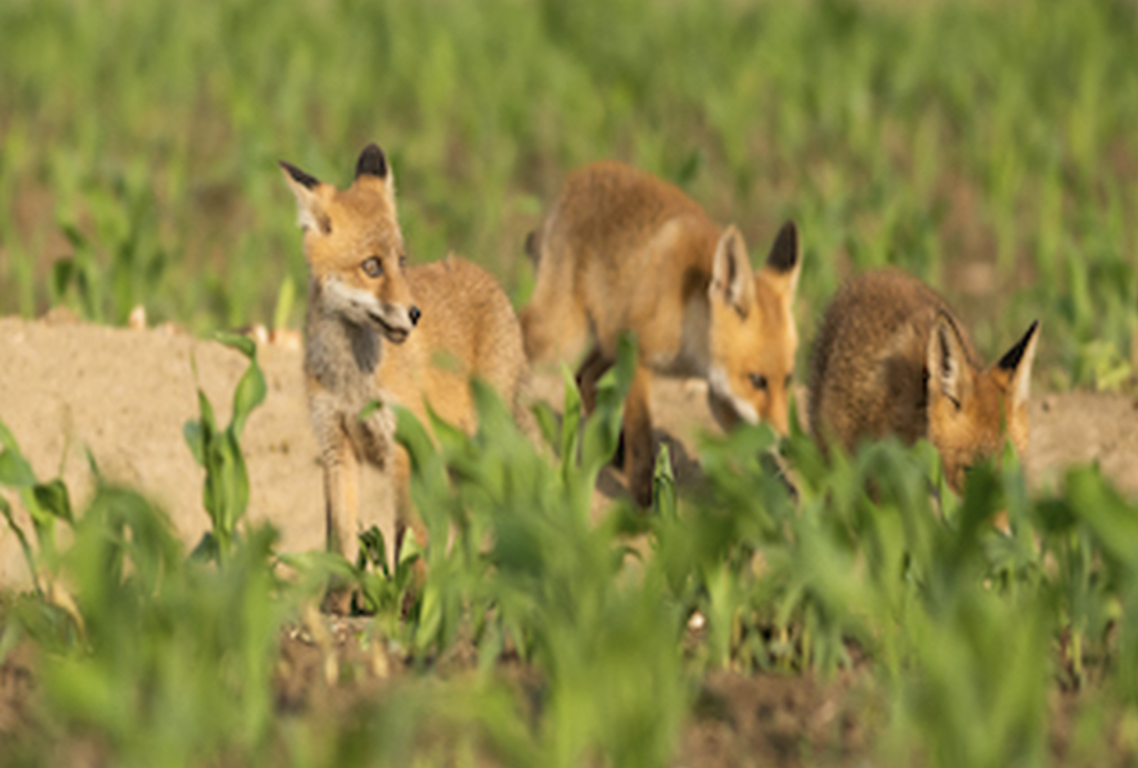Don’t let critters damage Your landscape, lawn, and gardens: part II
In Part I of this blog, we reviewed some measures that homeowners can take to keep coyotes and foxes from sitting up shop in your yard and the subsequent damage and problems they can cause. But there are many other critters that may need to be controlled, such as groundhogs, rabbits (their urine is toxic to grass, killing your lawn completely), raccoons, squirrels, and even deer, particularly if you live in the suburbs near open space.
Critters can ruin hours or even days of hard work. Whether its squirrels digging holes in the lawn, deer gobbling shrubs, or rabbits killing your grass, wildlife can quickly wipe out your landscape’s best features. The easiest way to prevent animals from ruining your paradise is by keeping them out of your yard, and here are ways to identify what critters are damaging your landscape.
Deer: Deer love plants, flowers, and edibles, and they have appetites that work overtime. A single deer can eat up to 10 pounds of food daily. When deer are munching, you’ll see missing buds, half-eaten fruits and vegetables, and torn up or ripped leaves. Deer droppings are pellet shaped, and tracks look like upside-down hearts.
Groundhogs: These hungry herbivores devour up to 1.5 pounds of plants daily, including leaves, flowers, fruits, and vegetables. They love to tunnel, and their burrows have round openings with piles of dirt beside them. Other signs of groundhogs include wide teeth marks on plants, fruits, and bark. Tracks show 4-clawed toes on front paws and 5-clawed toes in back.
Rabbits: Bunnies may look cute, but they can wipe out a vegetable or flower garden overnight. Signs of their handiwork include piles of pea-sized droppings, neat razor-trimmed leaves and stems, missing plants, and dead grass, which you cannot revive through any means. If bunnies are bedding down in your lawn, you’ll see tufts of fur and slight depressions. Rabbits can have a litter of 30 or more newborns several times each year, so of all the critters on the planet, rabbits usually cause the most damage. There’s an old saying that “rabbits are born pregnant," which isn’t true but it will seem true if you have a rabbit problem.
Raccoons: Active at night, raccoons frequently visit yards to forage in trash cans or dig up insects in lawn and mulch. If you have fruit trees, raccoons will deplete every single plum, cherry, apple, orange…you name it, and do so in rapid fashion. Raccoon families can often total six to 10 members, and they are completely comfortable around humans. Signs that a raccoon is present include torn trash bags, missing fish from a pond, emptied bird feeders, and portions of various fruit on the ground, deck, and patio.
Squirrels: When squirrels are at work, you’ll spot small holes in your planting beds and containers, plus half-eaten (or missing) seed-heads, fruit, or vegetables. They love to eat from bird feeders, so if you have one or more bird feeders, they may be the reason they’re targeting your yard.
As helpful that these signs may be, if you have a critter problem, you will actually see the animals on a regular basis…even daily.
One way to keep critters from damaging your landscape is to make your yard unattractive to them.
Repel them: Repellents are one of the easiest ways to ward off animals. These products feature scents that critters find unappealing. For best results with repellents, follow label instructions carefully. Dry granular repellents, which can repel rabbits, groundhogs, squirrels, and other small animals, offer good rain resistance. Also, a liquid spray will repel deer and rabbits.
Clean up: Your first line of defense against marauding animals is eliminating their hiding places, such as wood piles, brush, overgrown shrubbery, and dens under decks, patios, and porches, which may require trapping and relocating the animals. You can also contact your city’s animal control department for assistance. For rabbits, unfortunately, poisoning may be the only solution. Open spaces and neatly trimmed beds work particularly well to help discourage rabbits and groundhogs.
Remove food: Fill your garden with plants that deer and rabbits dislike, and pick edible produce as soon as it’s ripe to avoid luring groundhogs. Gather fallen fruit or nuts before squirrels turn them into a feast. Also, avoid letting pet food sit out overnight. It’s a big draw for raccoons.
Scare them: Dogs with free run of a fenced yard are one of the most effective wildlife deterrents. If you have an open yard and there are leash laws in your neighborhood, hook your dog up to a long, anchored dog leash for a while each day. Your dog will love it and critters will most likely move to avoid the disturbance. Also, a big dog is best. Little “yap dogs” will not frighten most critters.
Exclude them: You can erect a barrier to protect your yard, or individual plants, from foraging wildlife. A piece of netting or chicken wire around vulnerable plants can provide effective protection against rabbits, deer, groundhogs, and squirrels. But this is too much work and essentially means that the critters won. Try the other measures first. If they don’t work, have the animals trapped and relocated.
Critters can ruin hours or even days of hard work. Whether its squirrels digging holes in the lawn, deer gobbling shrubs, or rabbits killing your grass, wildlife can quickly wipe out your landscape’s best features. The easiest way to prevent animals from ruining your paradise is by keeping them out of your yard, and here are ways to identify what critters are damaging your landscape.
Deer: Deer love plants, flowers, and edibles, and they have appetites that work overtime. A single deer can eat up to 10 pounds of food daily. When deer are munching, you’ll see missing buds, half-eaten fruits and vegetables, and torn up or ripped leaves. Deer droppings are pellet shaped, and tracks look like upside-down hearts.
Groundhogs: These hungry herbivores devour up to 1.5 pounds of plants daily, including leaves, flowers, fruits, and vegetables. They love to tunnel, and their burrows have round openings with piles of dirt beside them. Other signs of groundhogs include wide teeth marks on plants, fruits, and bark. Tracks show 4-clawed toes on front paws and 5-clawed toes in back.
Rabbits: Bunnies may look cute, but they can wipe out a vegetable or flower garden overnight. Signs of their handiwork include piles of pea-sized droppings, neat razor-trimmed leaves and stems, missing plants, and dead grass, which you cannot revive through any means. If bunnies are bedding down in your lawn, you’ll see tufts of fur and slight depressions. Rabbits can have a litter of 30 or more newborns several times each year, so of all the critters on the planet, rabbits usually cause the most damage. There’s an old saying that “rabbits are born pregnant," which isn’t true but it will seem true if you have a rabbit problem.
Raccoons: Active at night, raccoons frequently visit yards to forage in trash cans or dig up insects in lawn and mulch. If you have fruit trees, raccoons will deplete every single plum, cherry, apple, orange…you name it, and do so in rapid fashion. Raccoon families can often total six to 10 members, and they are completely comfortable around humans. Signs that a raccoon is present include torn trash bags, missing fish from a pond, emptied bird feeders, and portions of various fruit on the ground, deck, and patio.
Squirrels: When squirrels are at work, you’ll spot small holes in your planting beds and containers, plus half-eaten (or missing) seed-heads, fruit, or vegetables. They love to eat from bird feeders, so if you have one or more bird feeders, they may be the reason they’re targeting your yard.
As helpful that these signs may be, if you have a critter problem, you will actually see the animals on a regular basis…even daily.
One way to keep critters from damaging your landscape is to make your yard unattractive to them.
Repel them: Repellents are one of the easiest ways to ward off animals. These products feature scents that critters find unappealing. For best results with repellents, follow label instructions carefully. Dry granular repellents, which can repel rabbits, groundhogs, squirrels, and other small animals, offer good rain resistance. Also, a liquid spray will repel deer and rabbits.
Clean up: Your first line of defense against marauding animals is eliminating their hiding places, such as wood piles, brush, overgrown shrubbery, and dens under decks, patios, and porches, which may require trapping and relocating the animals. You can also contact your city’s animal control department for assistance. For rabbits, unfortunately, poisoning may be the only solution. Open spaces and neatly trimmed beds work particularly well to help discourage rabbits and groundhogs.
Remove food: Fill your garden with plants that deer and rabbits dislike, and pick edible produce as soon as it’s ripe to avoid luring groundhogs. Gather fallen fruit or nuts before squirrels turn them into a feast. Also, avoid letting pet food sit out overnight. It’s a big draw for raccoons.
Scare them: Dogs with free run of a fenced yard are one of the most effective wildlife deterrents. If you have an open yard and there are leash laws in your neighborhood, hook your dog up to a long, anchored dog leash for a while each day. Your dog will love it and critters will most likely move to avoid the disturbance. Also, a big dog is best. Little “yap dogs” will not frighten most critters.
Exclude them: You can erect a barrier to protect your yard, or individual plants, from foraging wildlife. A piece of netting or chicken wire around vulnerable plants can provide effective protection against rabbits, deer, groundhogs, and squirrels. But this is too much work and essentially means that the critters won. Try the other measures first. If they don’t work, have the animals trapped and relocated.


 Menu
Menu




